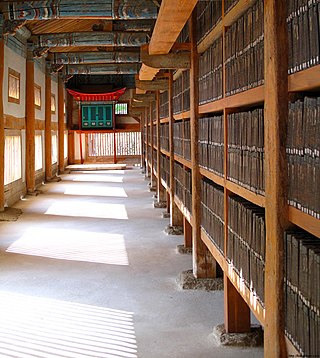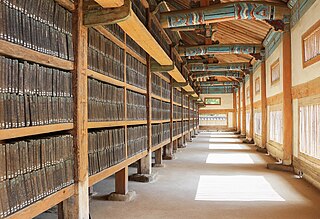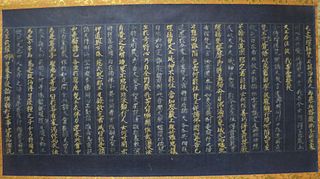
East Asian Buddhism or East Asian Mahayana is a collective term for the schools of Mahāyāna Buddhism that developed across East Asia which follow the Chinese Buddhist canon. These include the various forms of Chinese, Japanese, Korean, and Vietnamese Buddhism in East Asia. East Asian Buddhists constitute the numerically largest body of Buddhist traditions in the world, numbering over half of the world's Buddhists.

The Tripiṭaka Koreana or Palman Daejanggyeong is a Korean collection of the Tripiṭaka, carved onto 81,258 wooden printing blocks in the 13th century.

The Chinese Buddhist canon refers to a specific collection of Chinese language Buddhist literature that is deemed canonical in Chinese, Japanese, Korean, and Vietnamese Buddhism. The traditional term for the canon is "Great Storage of Scriptures". The concept of the Chinese Buddhist canon was influenced by the Indian Buddhist concept of a Tripitaka, literally meaning 'three baskets' - sutras, Vinaya, and Abhidharma. However, Chinese Buddhists historically did not have access to a Tripitaka of Indian Buddhist texts. Rather, individual texts were brought to China individually or in small batches and translated one-by-one. This lead to the creation of a distinct Chinese Buddhist canon.

Woodblock printing or block printing is a technique for printing text, images or patterns used widely throughout East Asia and originating in China in antiquity as a method of printing on textiles and later paper. Each page or image is created by carving a wooden block to leave only some areas and lines at the original level; it is these that are inked and show in the print, in a relief printing process. Carving the blocks is skilled and laborious work, but a large number of impressions can then be printed.

Daoxuan was an eminent Tang dynasty Chinese Buddhist monk. He is perhaps best known as the patriarch of the four-part Vinaya school. Daoxuan wrote both the Continued Biographies of Eminent Monks and the Standard Design for Buddhist Temple Construction. Legends retold in his biographies also associate him to a relic of the Buddha which came to be called Daoxuan's tooth, one of the four tooth relics enshrined in the capital of Chang'an during the Tang dynasty. He is said to have received the relic from Nezha, a divinity associated with Indra.

The Yulanpen Sutra, also known as the Ullambana Sutra, is a Mahayana sutra concerning filial piety. It was translated from an Indic language and is found in Taisho 685 and Taisho 686 in Volume 16, the third volume of the Collected Sutra Section. Taisho 685 was translated by Dharmarakṣa from 265-311 CE and is entitled: 'The Buddha Speaks the Yulanpen Sutra'. Taisho 686 was translated by an unknown or lost translator during the Eastern Jin Dynasty and is entitled: 'The Buddha Speaks the Sutra of Offering Bowls to Repay Kindness'. According to Karashima, Taisho 686 is basically a more idiomatic adaptation of Taisho 685. It records the events which followed after one of the disciples of Shakyamuni Buddha, Maudgalyayana, achieves Abhijñā and uses his newfound powers to search for his deceased parents. In the end, Maudgalyayana finds his mother in the preta world and with the assistance of the Buddha, is able to save her. The East Asian Ghost Festival is based on this sutra.

The Śūraṅgama Sūtra is a Mahayana Buddhist sutra that has been especially influential on Korean Buddhism and Chinese Buddhism. It was particularly important for Zen/Chan Buddhism. The doctrinal outlook of the Śūraṅgama Sūtra is that of Buddha-nature, Yogacara thought, and esoteric Buddhism.

Takakusu Junjirō, who often published as J. Takakusu, was a Japanese academic, an advocate for expanding higher education opportunities, and an internationally known Buddhist scholar. He was an active Esperantist.

The Brahmajāla Sūtra, also called the Brahma's Net Sutra, is a Mahayana Buddhist Vinaya Sutra. The Chinese translation can be found in the Taishō Tripiṭaka. The Tibetan translation can be found in Peking (Beijing) Kangyur 256. From the Tibetan it was also translated into Mongolian and the Manchu languages. It is known alternatively as the Brahmajāla Bodhisattva Śīla Sūtra.

Nanjō Bun'yū (南条文雄) was a Buddhist priest and one of the most important modern Japanese scholars of Buddhism. Nanjō was born to the abbot of Seiunji Temple (誓運寺), part of the Shinshu Ōtani sect (真宗大谷派) of the Higashi Honganji (東本願寺) branch of Jodo Shinshu.

Yunju Temple is a Buddhist temple located in Fangshan District, 70 kilometers (43 mi) southwest of Beijing and contains the world's largest collection of stone Buddhist sutra steles. Yunju Temple also contains one of only two extant woodblocks for the Chinese Buddhist Tripitaka in the world as well as rare copies of printed and manuscript Chinese Buddhist Tripitakas. It also has many historic pagodas dating from the Tang and Liao Dynasty.

The Taishō Tripiṭaka is a definitive edition of the Chinese Buddhist canon and its Japanese commentaries used by scholars in the 20th century. The Taishō Tripiṭaka project was initiated by the Department of Sanskrit and Indian Studies at Tokyo Imperial University. It was edited by Takakusu Junjiro and others.

Tipiṭaka or Tripiṭaka, meaning "Triple Basket", is the traditional term for ancient collections of Buddhist sacred scriptures. The Tripiṭaka is composed of three main categories of texts that collectively constitute the Buddhist canon: the Sutra Piṭaka, the Vinaya Piṭaka, and the Abhidhamma Piṭaka.

The Pāli Canon is the standard collection of scriptures in the Theravada Buddhist tradition, as preserved in the Pāli language. It is the most complete extant early Buddhist canon. It derives mainly from the Tamrashatiya school.
The Sanjiejiao or Pufazong was a religious movement based on the teachings of the Chan Buddhist monk Xinxing.

The Yiqiejing yinyi 一切經音義 "Pronunciation and Meaning in the Complete Buddhist Canon" was compiled by the Tang dynasty lexicographer monk Huilin 慧琳 as an expanded revision of the original Yiqiejing yinyi compiled by Xuanying 玄應. Collectively, Xuanying's 25-chapter and Huilin's 100-chapter versions constitute the oldest surviving Chinese dictionary of Buddhist technical terminology. A recent history of Chinese lexicography call Huilin's Yiqiejing yinyi "a composite collection of all the glossaries of scripture words and expressions compiled in and before the Tang Dynasty" and "the archetype of the Chinese bilingual dictionary".

Kaiyuan Temple is a Buddhist temple located in Xiangqiao District of Chaozhou, Guangdong, China.
Zhìshēng was a Chinese Buddhist monk and bibliographer from the Tang dynasty. Little is known about his life, but it is known that he became a monk early in his life and studied Mahayana and Theravada doctrines, and was particularly knowledgeable on the Vinaya. He is best known for his Catalogue of Śākyamuṇi’s Teachings of the Kaiyuan Era of the Great Tang Era or simply the Kaiyuan Catalogue (T2154) completed in 730 CE. This was significant because the organisation of it formed the basic structure of the Chinese Buddhist Tripiṭaka. "It is generally considered the single most important bibliographical catalogue in terms of the role it played in the history of East Asia Buddhist Canonical publications".
Lìyán' was a Buddhist monk (沙門) from Kucha. According to the Biographies of eminent monks compiled during the Song period, he was originally from Kucha. He was ordained in 726, and is said to have mastered a wide range of Buddhist texts and the Chinese classics. He acted an amanuensis to the Indian Buddhist monk Dharmacandra when he translated Pǔbiànzhìcáng bōrěbōluómìduō xīnjīng, a version of the Prajñāpāramitā-hṛdaya-sūtra in 738 CE.

The Āgama Section is a division of the Taishō Tripiṭaka that contains sūtras related to the Āgamas, roughly corresponding to the texts of the Sutta Piṭaka of the Pāli Canon. It corresponds to the first two volumes of the Taishō Tripiṭaka and corresponds to text numbers 1–151. Notable collections within this section include the Dīrghāgama, Madhyamāgama, Saṃyuktāgama, and the Ekottarāgama, while the section also includes individual sūtras that were translated separately from these collections, but which contain parallels therein, such as the Dharmacakrapravartana Sūtra.















